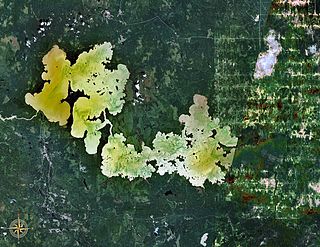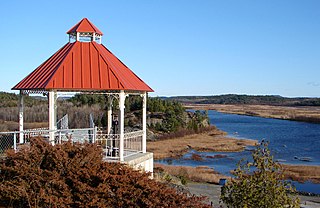
Lake Abitibi is a shallow lake in northeastern Ontario and western Quebec, Canada. The lake, which lies within the vast Clay Belt, is separated in two distinct portions by a short narrows, making it actually 2 lakes. Its total area is 931 square kilometres (359 sq mi), and net area 903 square kilometres (349 sq mi). The lake is shallow and studded with islands. Its shores and vicinity are covered with small timber.

The Spanish River is a river in Algoma District, Sudbury District and Greater Sudbury in Northeastern Ontario, Canada. It flows 338 kilometres (210 mi) in a southerly direction from its headwaters at Spanish Lake and Duke Lake to its mouth at the North Channel of Lake Huron just outside the community of Spanish.

The Steel River is a river in Thunder Bay District in northern Ontario, Canada. It empties into the north shore of Lake Superior east of Terrace Bay. Most of the river is protected in a provincial waterway park. It is a popular location for canoeing and fishing.
The Pukaskwa River is a river in Thunder Bay District and Algoma District in Northern Ontario, Canada. It is in the Great Lakes Basin and is a tributary of Lake Superior, which it enters at the south end of Pukaskwa National Park. It is a remote, pristine, free-flowing, medium-sized Shield river, with lots of whitewater, best travelled in spring.
The Obabika River Provincial Park is a provincial park in Ontario, Canada, straddling across the boundaries of the Sudbury, Nipissing, and Timiskaming Districts. While it is named after and includes the Obabika River, the bulk of the park extends north of Obabika Lake to the eastern boundary of Lady Evelyn-Smoothwater Provincial Park.
The Temagami River, formerly spelled as Timagami River, is a river in the Nipissing District of Ontario, Canada, in the Temagami region. Its source is Lake Temagami and flows through Cross Lake and Red Cedar Lake. It flows into the Sturgeon River at the community of River Valley.

The Attawapiskat River is a river in Kenora District in northwestern Ontario, Canada, that flows east from Attawapiskat Lake to James Bay. It is the third largest river entirely in Ontario.

The Sturgeon River Provincial Park is a provincial park in northern Ontario, Canada, that protects about 70 kilometres (43 mi) long section of the Sturgeon River and its banks, from Woods Lake to the Sudbury-Nipissing District boundary. It was established in 1989 and expanded in 2005. It protects outstanding water routes that provide recreational canoe camping opportunities. Other activities include hunting and fishing.
Attawapiskat Lake is a lake in Kenora District, Ontario, Canada. The primary inflows are the Otoskwin River, the Marten-Drinking River and the Pineimuta River. The two outflows are the Attawapiskat River and the North Channel, which itself flows into the Attawapiskat River.
The Makobe River is a river in northeastern Ontario, Canada. It is in the Saint Lawrence River drainage basin, and is a left tributary of the Montreal River.

La Cloche Provincial Park is a provincial park at the boundary of Algoma and Sudbury Districts in Ontario, Canada. The park consists of an unspoiled section of the La Cloche Mountains that stretch along the North Channel of Georgian Bay, as well as several islands in the channel.
The East English River Provincial Park is a linear waterway park in Kenora District, Ontario, Canada. It includes a 200 metres (660 ft) wide strip of land on both sides of the English River and its lakes, from the intersection of Highway 599 to Minnitaki Lake. It was established in 2003 to protect natural features, that are representative of the area, and high quality recreational canoe routes with over 30 sets of rapids. The park's notable features include white pine forest at the northern extent of its range, white elm and burr oak, caribou habitat and calving locations, fisheries, and archaeological sites.
Solace Provincial Park is a remote provincial park in Sudbury District, Ontario, Canada. It was established in 1985 and protects a series of lakes that provide backcountry canoeing opportunities. It is characterized by boreal forest, mostly jack pine conifer forest with mixed forest including white birch. The roadless park, with topography and scenery similar to the adjacent Lady Evelyn-Smoothwater Provincial Park, is considered as "one of the most isolated, wild places in Ontario."

The Kopka River is a river in northwestern Ontario, Canada. It forms at the height-of-land west of Lake Nipigon, flowing through rugged wilderness of Ontario's northern boreal forest, and drains into Wabinosh Lake.

Kesagami Provincial Park is in Cochrane District of Northern Ontario, Canada. It was established in 1983 and provides backcountry canoeing, camping, and fishing opportunities. The bulk of the park consists of a large near-rectangular piece of land surrounding Kesagami Lake, as well as a linear park that protects a 200 metres (660 ft) wide strip of land on both sides of the Kesagami River from Kesagami Lake to its mouth at the Harricana River. Its name means "warm water".
The Pipestone River is a river in northwestern Ontario, Canada. It is a major tributary of Winisk River via Wunnummin Lake. This pristine river flows through the rugged wilderness of Ontario's northern boreal forest, and drains into Wunnummin Lake.
The Pipestone River Provincial Park is a provincial park in northern Ontario, Canada, roughly 200 kilometres (120 mi) north of Sioux Lookout. It is a non-contiguous linear waterway park that consists of 3 segments, protecting 316-kilometre-long (196 mi) portions of the Pipestone, Morris, Williams, and Otoskwin Rivers. The segments are separated by an unprotected portion of the Pipestone River at Kingfisher 2A reserve, and between Kecheokagan Lake and the Nord Road. It was established on January 3, 1989, and provides backcountry whitewater canoeing and camping opportunities.
St. Raphael Provincial Park is a provincial park in northern Ontario, Canada, roughly halfway between Sioux Lookout and Pickle Lake, straddling the boundary of Kenora and Thunder Bay Districts. It was established on May 22, 2003, and provides backcountry canoeing and camping opportunities.
Lake of the Woods Provincial Park is a provincial park in northwestern Ontario, Canada. It protects several islands in Lake of the Woods, in both Kenora and Rainy River Districts. It was established in 1967 and expanded with 11,800 hectares in 1985. It provides backcountry camping opportunities.
The Otoskwin River is a river in Northwestern Ontario, Canada. This river, once part of a major fur-trade route to James Bay, is a significant tributary of the Attawapiskat River via Attawapiskat Lake.









